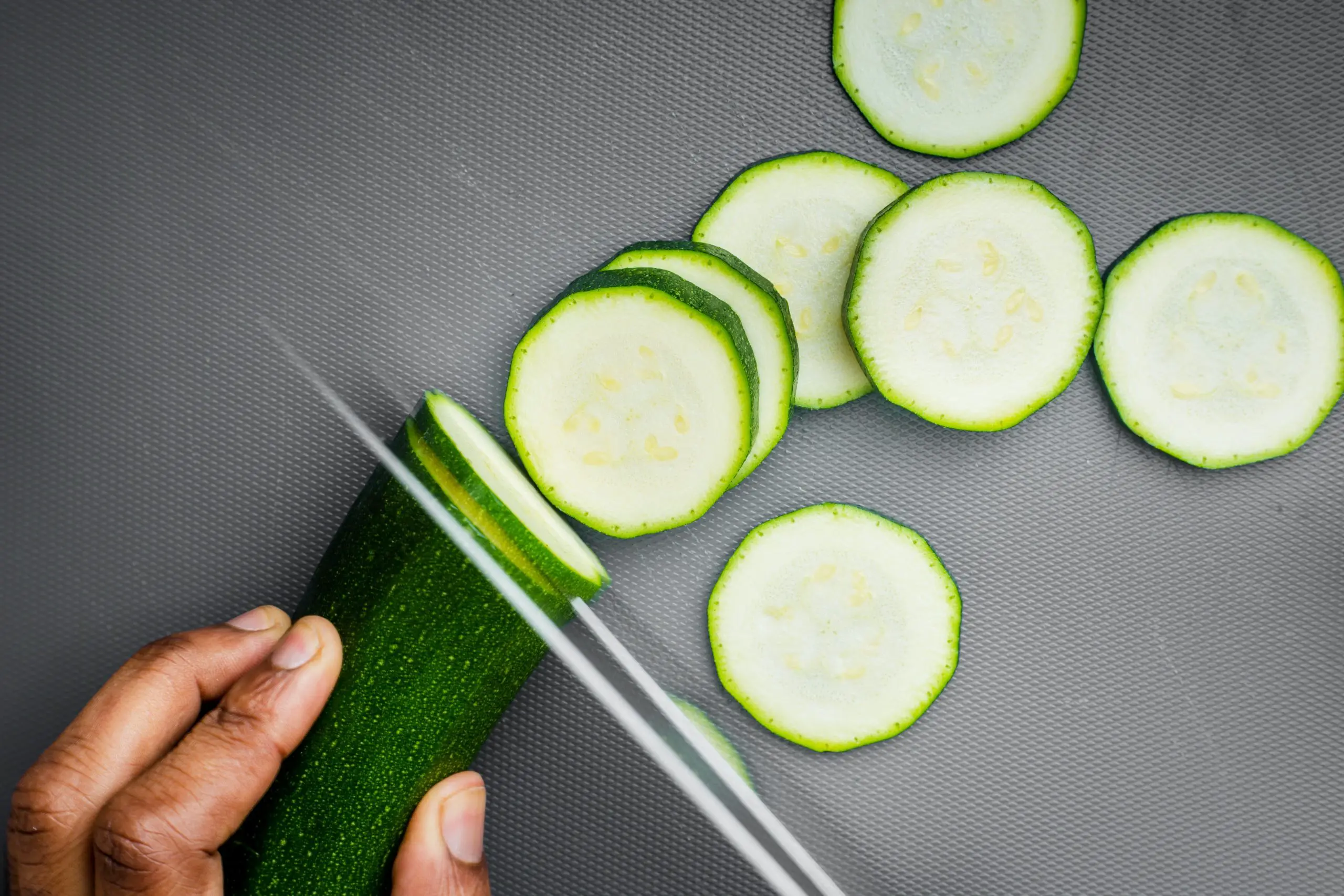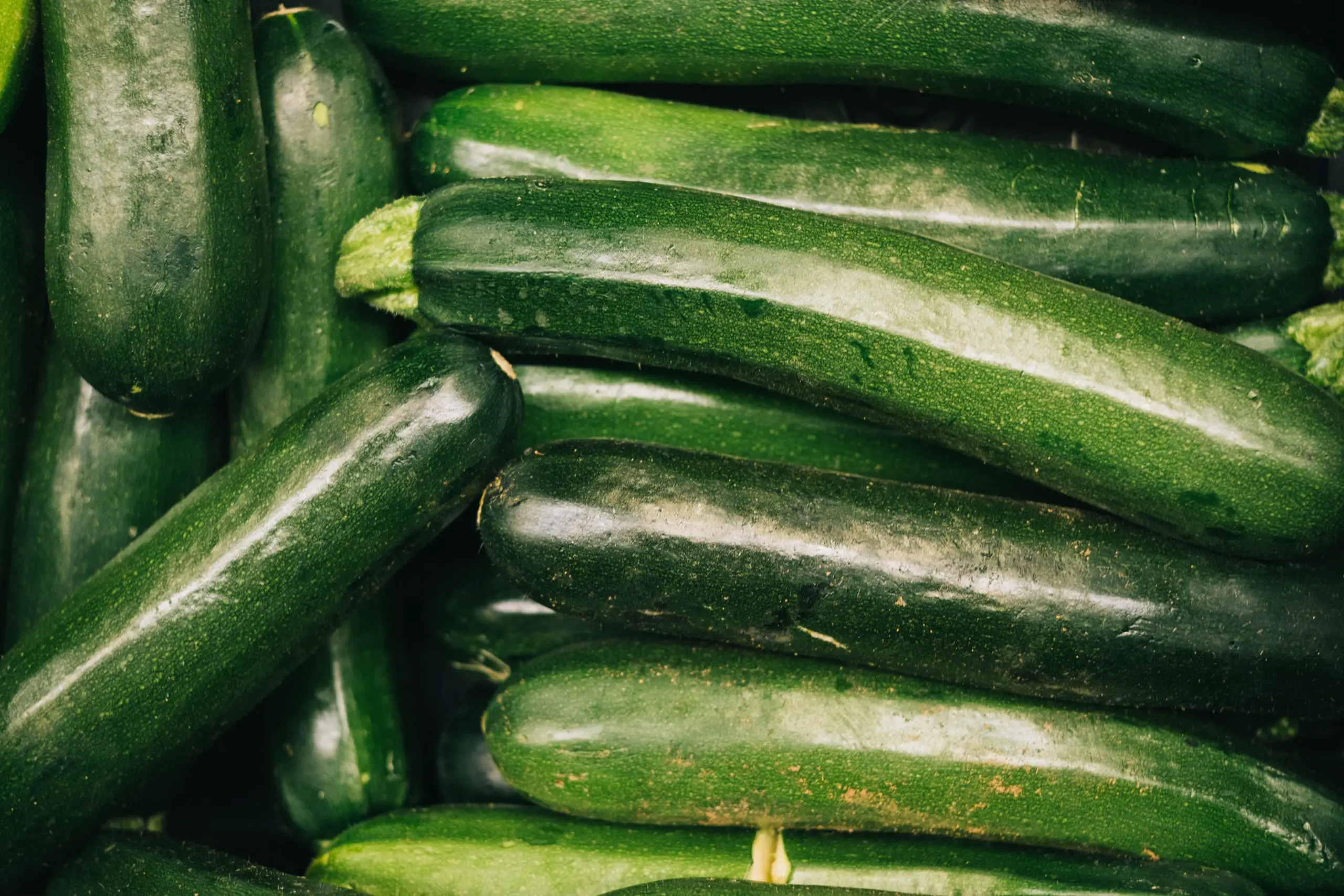Zucchini is a versatile vegetable that can be used in various dishes. It can be frozen and used in stews and soups. However, if you freeze it, you must be careful about how much you freeze and how long you store it. This is to ensure that it retains its color and texture.
Slices of blanched zucchini should be placed in a single layer on a baking sheet coated with parchment paper and placed in the freezer for two to four hours or until firm. Once the vegetables are frozen, move them to freezer bags that can be sealed snugly after being squeezed with as much air as possible. Place the bags in the freezer for up to 6 months after labeling.

How do you Freeze Zucchini?
You can quickly freeze fresh zucchini for later use in baked goods, soups, stews, or sautéed dishes if you have a surplus of veggies in your garden or at the shop. Here is a step-by-step tutorial on freezing extra zucchini in their fresh state.
1. Wash your zucchini. Always wash your produce before eating to remove any potential dirt, filth, or pesticide residue from the flesh.
2. Make the zucchini ready. Cut the remaining zucchini into half-inch slices after removing approximately an inch from each end of the uncooked vegetable. Instead of cutting your vegetables into slices, you may core and shred them. If your zucchini has seeds, remove them with a spoon because they retain moisture.
3. Steam the zucchini. To extend the life of your zucchini and prevent freezer burn, blanch it before freezing and storing it. To blanch the zucchini, carefully add the pieces to a big pot of boiling water. After approximately a minute, remove the zucchini from the boiling water using a colander, strainer, or slotted spoon, and immediately submerge them in an ice bath to cool them. Blanching will aid in reducing the enzymes in zucchini that might cause the vegetable’s texture to become softer. After blanching your zucchini, be careful to dry it completely.
4. Freeze food in separate portions. Please ensure the zucchini slices do not overlap when you arrange them in a single layer on a baking sheet coated with parchment paper. Keep in the freezer until the zucchini pieces are completely frozen.
5. Put in a freezer bag. When the zucchini pieces are frozen, put them all in a big plastic bag and use a straw or vacuum sealer to remove any air. Restore it to the freezer so you can enjoy it later. They can remain like the way in the freezer for six to twelve months.
5 Tips for Frozen Zucchini
With so many uses, frozen zucchini might become a staple in your kitchen. Use these suggestions to get the most out of your frozen preserved zucchini.
1. Take the moisture out. These vegetables retain a lot of moisture, so you must remove as much as possible before freezing your zucchini. Make sure to press out as much moisture as possible from the zucchini with a paper towel or cheesecloth before freezing, especially if you’re using frozen zucchini.
2. Put a date on the frozen zucchini. Although the risk of freezer burn prevents frozen foods from having an indefinite shelf life, they can last very long. If you also have other frozen vegetables, mark your bags with the date you created your frozen zucchini.
3. Add to soup. Cooking zucchini can help bring out its sweetness, adding another depth of complexity to your spicy or hearty soups. You won’t need to defrost the frozen zucchini before using it in a soup if you use it that way.
4. Create bread. Defrost your zucchini if you use frozen zucchini in your bread recipe. Additionally, you want to remove any extra moisture accumulated throughout the thawing procedure.
5. Make the noodles. Zoodles, also known as zucchini noodles, are a low-carbohydrate, healthy alternative to pasta produced with a spiralizer. Your grated or shredded zucchini can be defrosted in the fridge or a dish of cool water. After soaking, pat the excess moisture dry with a paper towel. Remember that zucchini is mainly water; soaking or freezing might make the vegetable’s segments soggy and mushy.
How Long does Frozen Zucchini Last?
Sadly, even frozen zucchini has a limited shelf life. If frozen, it should be consumed within three months. It is simple to include in soups, casseroles, and spaghetti sauces; stir fries and salads can be a little more challenging. See our collection of zucchini recipes that work in an oven for inspiration.
For a taste of summer, whenever you want, start freezing zucchini! And discover how to freeze other favorites with our comprehensive guide to food preservation.
How to Use your Frozen Zucchini?
When choosing a recipe, remember that it has a softer texture than fresh zucchini. The zucchini element of the recipe should be cooked for less time. Almost any cooked recipe can be used with frozen zucchini.
When cooking, frozen zucchini doesn’t need to be thawed. Put it in soups, casseroles, pasta, and more by tossing it in. Before using shredded zucchini in cake or bread mixes for baking, it is important to defrost the zucchini and squeeze out any extra moisture.
Can you Freeze Zucchini Without Blanching it?
Unblanched zucchini can be frozen; thus, yes! Blanching veggies before freezing them is believed to inactivate their enzymes, which may result in discoloration or mushy foods.
However, in my experience, after you thaw frozen vegetables, they are usually mushy than fresh vegetables. (This also applies to frozen green beans.)
Most of the time, I use frozen zucchini in smoothies, so there isn’t much point in blanching it if I’m going to use it frozen. You can save time by avoiding the blanching step.
Remember that most smoothie recipes nearly NEVER benefit from the flavor or color added by frozen zucchini. It’s more like putting a few ice cubes into a smoothie with more nutrients than ice.
It can be incorporated into a low-sugar smoothie recipe or any other smoothie you enjoy.
How to Defrost Zucchini?
It’s time to remove the zucchini from the freezer so you can start cooking with it. Here’s how to defrost zucchini quickly.
- The frozen zucchini should be removed. Here is a 5-month-old zucchini to demonstrate how vibrant and fresh it remains.
- Put the zucchini in the refrigerator to defrost naturally overnight or in the microwave for a quick defrost.
- The zucchini should be placed in a sieve once it has defrosted and should be gently squeezed. We want to ensure that all the extra water is removed from your zucchini because it probably contains some added water. This is especially important if we plan to bake with it.
- We squeezed quite an amount of water out of it, as you can see!
- Now that your fresh zucchini has been defrosted, you may use it for recipes!
Can you Freeze Sliced Zucchini?
I prefer freezing sliced zucchini since it is the most versatile cooking technique. I don’t have to thaw frozen zucchini slices before adding them to soups, stews, and other meals.
Although frozen zucchini isn’t fantastic for stir-fries or salads, frozen zucchini slices aren’t the best for those, either!
- Wash the zucchini under running water from the faucet to get rid of any dirt or debris.
- The zucchini’s ends should be trimmed and discarded.
- 14 to 12-inch rounds of zucchini should be cut.
- Zucchini should be blanched as directed in the section above.
- Place the zucchini slices in an even layer on a baking sheet lined with parchment paper after being placed in the ice bath and thoroughly dried.
- Slices of zucchini should be frozen for 1 to 2 hours or until firm. In the freezer bag, this keeps the zucchini from freezing into a single large mass.
- Transfer the frozen zucchini to a freezer bag with a zipper closure or a vacuum sealer.
- Put a date on the label and freeze the zucchini.
Can you Freeze Zucchini Halves?
Future zucchini boat creations can be made with frozen zucchini half-halves. The frozen zucchini halves can be diced or sliced later if you change your mind and don’t wish to build zucchini boats.
Please take note that freezing zucchini halves requires blanching beforehand! You’ll need to consider that because they also take up more room in the freezer.
- Wash the zucchini under running water from the faucet to get rid of any dirt or debris.
- The zucchini’s ends should be trimmed and discarded.
- Zucchini should be cut in half lengthwise.
- Scoop out the zucchini seeds and spongy them inside with a spoon. Avoid removing too much of the harder zucchini flesh with a spoon.
- The zucchini in the manner described above. You must blanch zucchini halves for 3 minutes.
- After cooling the ice bath, pat dry before arranging in a single layer on a baking sheet covered with parchment paper.
- 1 to 2 hours of hard freezing are required.
- Seal inside vacuum or freezer bags.
- Add a date, label, and freeze.
Can you Freeze Shredded Zucchini?
It’s not necessary to blanch the chopped zucchini before freezing it. Once the zucchini has been shredded, you need to carefully wring off any extra moisture. For this, paper towels or a fresh kitchen towel work great.
If you want to use the shredded zucchini soon in soups, sauces, muffins, or zucchini bread, freezing it is a terrific idea.
- Wash the zucchini under running water from the faucet to get rid of any dirt or debris.
- The zucchini’s ends should be trimmed and discarded.
- Use a box grater with medium-sized holes to shred the zucchini.
- Working with 1 to 2 cups of shredded zucchini at a time, squeeze out as much moisture as possible using paper towels or clean kitchen towels. This will shield the texture of the zucchini from freezer burn.
- Zucchini should be packaged in zip-top freezer bags or vacuum bags in increments of 1 cup. I like to freeze it in smaller portions to defrost just the right amount of shredded zucchini for future dishes.
- The shredded zucchini should be dated, labeled, and frozen. I prefer to freeze items flat in zip-top bags until they are completely frozen. I then raise them straight up to free up freezer space.
Should you Thaw Frozen Zucchini Before Using it?
Depending on how you intend to use it!
- If using shredded zucchini in baking, thaw it beforehand! Before incorporating into batters, defrost, drain, and allow room temperature.
- Don’t defrost zucchini before adding it to sauces, soups, stews, or smoothies! It can be added right away to whatever you’re cooking.
- Thaw it if you’re making zucchini boats! After defrosting, remove any extra moisture, fill, and bake.
Conclusion
We sincerely hope that our article about freezing zucchini has been helpful to you. As you can see, it’s quite straightforward to freeze zucchini. After giving it a shot once or twice, you’ll be able to get the feel of it.
